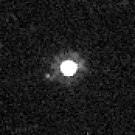User:Bluedecklibrary/星际快车
{{vfd|百度和谷歌搜索“星际快车”和“星际日光层探测器”均未查到任何和中国航天计划有关的资料,另外所有来源都是英文来源,没有中国国家航天局的官方来源证实该计划,疑似恶作剧(中国的行星探测器其实已经命名了,叫做“天问X号”,不叫“星际快车”)|date=2022/08/01}}
{{Multiple issues| {{Copy edit|time=2022-04-21T07:30:36+00:00}} {{Rough translation|time=2022-04-21T07:31:30+00:00}} {{Disputed|time=2022-08-02T04:07:19+00:00}} {{Hoax|time=2022-08-02T04:07:19+00:00}} {{Citecheck|time=2022-08-02T04:07:19+00:00}} }} {{Infobox spaceflight | name = IHP-1 | image = | image_caption = | mission_type = 日光层科学,行星飞越 | operator = 国家航天局 | mission_duration = 25年(计划)
| launch_date = 提议时间:2024 年 5 月[1][2]
|interplanetary = {{Infobox spaceflight/IP
|type = flyby |object = 地球 |note = 重力助推 |distance = |arrival_date = 2025 年 10 月 [2] }}
{{Infobox spaceflight/IP
|type = flyby
|object = 地球
|note = 重力助推
|distance =
|arrival_date = 2027 年 12 月 [2]
}}
{{Infobox spaceflight/IP
|type = flyby
|object = 木星
|note =
|distance =
|arrival_date = 2029 年 3 月 [2]
}}
{{Infobox spaceflight/IP
|type = flyby
|object = 创神星
|note =
|distance = 待定
|arrival_date = 待定 [1][3]
}}
}} {{Infobox spaceflight | name = IHP-2 | mission_type = 日光层科学,行星飞越 | operator = 国家航天局 | mission_duration = 25年(计划)
| launch_date = 提议时间:2024-2026 年 5 月[1][4]
|interplanetary = {{Infobox spaceflight/IP
|type = flyby |object = 地球 |note = 重力助推 |distance = |arrival_date = 2027 年 5 月 [2] }}
{{Infobox spaceflight/IP
|type = flyby
|object = 地球
|note = 重力助推
|distance =
|arrival_date = 2032 年 3 月 [2]
}}
{{Infobox spaceflight/IP
|type = flyby
|object = 木星
|note =
|distance =
|arrival_date = 2033 年 5 月 [2]
}}
{{Infobox spaceflight/IP
|type = flyby
|object = 海王星
|note =
|distance = 1,000 公里
|arrival_date = 2038 年 1 月 [2]
}}
{{Infobox spaceflight/IP
|type = flyby
|object = 柯伊伯带天体
|note = 待定
|distance = 待定
|arrival_date = 待定 [2]
}}
}}
星际快车 (Interstellar Express) 或星际日光层探测器 (Interstellar Heliosphere Probe) 是中国国家航天局提出的用于探索日光层和星际空间的一对探测器[3] 这些探测器将于 2024 年发射,并沿着不同的轨迹与木星相遇,以帮助它们离开太阳系。第一个探测器“IHP-1”将飞向日球层的前端,而第二个探测器“IHP-2”将在靠近尾部飞行,并于 2038 年 1 月掠过海王星和海卫一[5][2] 2030 年发射的另一个探测器可能会飞到日球层的北半部。[1][6] 它们也将分别是第六艘和第七艘离开太阳系的航天器,以及第一个这样做的非美国探测器。
历史[编辑]
迄今为止,只有两个探测器探索了星际介质:旅行者1号和旅行者2号。两艘旅行者号都使用引力辅助将它们带出黄道:旅行者1号于1980年借助土星引力,1989年旅行者2号借助海王星引力。 然而,这两个探测器都没有飞过黄道,都朝着日光层银河系中心方向前进,就像美国宇航局于2006年发射的探测器新视野号一样。后来的航天器,如卡西尼-惠更斯号,收集了有关日光层如何与星际介质相互作用,这表明日光层的形状不像彗星,而是呈球形。
概述[编辑]
星际快车的目标是到中华人民共和国成立一百周年,即2049年时达到100个天文单位。[2] 每个探测器的重量约为 200 公斤,使用放射性同位素热电发生器(RTG)作为动力,并携带 50千克或以上的科学有效载荷,包括光学相机、磁力计、尘埃探测器以及中性原子和粒子有效载荷。[1][3][2] 他们还可能研究与星际空间相比电离的异常宇宙射线,以帮助理解日球层为何如此运作,同时还探索行星际尘埃和星际介质。[5] 机头和机尾航天器将使用 RTG 提供动力; 潜在的北日光层探测器将使用核反应堆。[1][6] 根据是否使用单组元推进剂或离子推进,探测器将使用 长征 3B 或 长征 5 火箭发射。[3][1]
目前关于探测器的信息很少; 例如,两者的发射日期可能是 2024 年或 2025 年,但一些消息来源称“IHP-2”可能会在 2026 年发射。[4] 虽然计划在“IHP-1”的地球重力辅助后飞越木星,但据称也考虑飞越土星。[7] 创神星和創衛一目前被认为是潜在的飞越目标,[2][1] 尽管由于轨道定位,它们更有可能完成“IHP-1”。半人马小行星也在考虑探索。[1][5]
軌道[编辑]
“IHP-1”将于 2024 年 5 月发射。2025 年 10 月,它将返回地球进行重力助推,然后在 2027 年 12 月返回地球进行另一次重力助推。 2029 年 3 月,探测器将飞越木星,将其发送到朝向日球层前端的轨道,并可能沿途观察 半人马小行星 或柯伊伯带天体,包括可能的 创神星。[1] 到 2049 年,探测器将距离地球 85 个天文单位。
“IHP-2”将于 2024 年 5 月或 2025 年发射,但同样会分别在 2027 年 5 月和 2032 年 3 月接受来自地球的两次重力助推。 2033 年 5 月的木星飞越将使其在 2038 年 1 月飞越海王星和海卫一的路径上飞越云层顶部仅 1,000 公里的高度。 探测器还将在飞越之前释放大气撞击器。[3] 在飞越之后,探测器将访问另一个柯伊伯带天体,到 2049 年,探测器将离开地球 83 个天文单位,朝向尚未探索的日球层尾部。
飞越的目标[编辑]
IHP-1[编辑]
-
地球 (2x 重力助推)
-
木星(飞过)
-
创神星和創衛一 (飞过)
IHP-2[编辑]
-
地球 (2x 重力助推)
-
木星(飞过)
-
海王星(飞过)
-
海卫一(飞过)
参考[编辑]
{{Reflist}}
外部链接[编辑]
{{中华人民共和国航天}} {{長征系列運載火箭}} {{木星任務}} {{海王星}} {{小行星任務}}
- ^ 1.00 1.01 1.02 1.03 1.04 1.05 1.06 1.07 1.08 1.09 {{cite journal |last1=Wu |first1=Weiren |last2=Yu |first2=Dengyun |last3=Huang |first3=Jiangchuan |last4=Zong |first4=Qiugang |last5=Wang |first5=Chi |last6=Yu |first6=Guobin |last7=He |first7=Rongwei |last8=Wang |first8=Qian |last9=Kang |first9=Yan |last10=Meng |first10=Linzhi |last11=Wu |first11=Ke |last12=He |first12=Jiansen |last13=Li |first13=Hui |title=Exploring the solar system boundary |journal=SCIENTIA SINICA Informationis |date=2019-01-09 |volume=49 |issue=1 |pages=1 |doi=10.1360/N112018-00273 |url=https://www.sciengine.com/publisher/scp/journal/SSI/49/1/10.1360/N112018-00273?slug=fulltext |language=en |issn=2095-9486 |access-date=2021-07-01 |archive-date=2021-09-29 |archive-url=https://web.archive.org/web/20210929080419/https://www.sciengine.com/ueditor/unify?action=config&&noCache=1632902656694 |dead-url=no }}
- ^ 2.00 2.01 2.02 2.03 2.04 2.05 2.06 2.07 2.08 2.09 2.10 2.11 2.12 {{cite news |last1=Jones |first1=Andrew |title=China Considers Voyager-like Mission to Interstellar Space |url=https://www.planetary.org/articles/china-voyager-like-interstellar-mission |access-date=29 April 2021 |work=Planetary.org |publisher=The Planetary Society |date=November 19, 2019 language=en |archive-date=2021-12-02 |archive-url=https://web.archive.org/web/20211202044254/https://www.planetary.org/articles/china-voyager-like-interstellar-mission |dead-url=no }}
- ^ 3.0 3.1 3.2 3.3 3.4 {{cite news |last1=Jones |first1=Andrew |title=China to launch a pair of spacecraft towards the edge of the solar system |url=https://spacenews.com/china-to-launch-a-pair-of-spacecraft-towards-the-edge-of-the-solar-system/ |access-date=29 April 2021 |work=SpaceNews |publisher=SpaceNews |date=16 April 2021 |language=en |archive-date=2021-09-29 |archive-url=https://web.archive.org/web/20210929080320/https://spacenews.com/china-to-launch-a-pair-of-spacecraft-towards-the-edge-of-the-solar-system/ |dead-url=no }}
- ^ 4.0 4.1 {{cite news |last1=Shim |first1=Chang-seop |title=중국, 인터스텔라 탐사에 나설까 – Sciencetimes |url=https://www.sciencetimes.co.kr/news/%EC%A4%91%EA%B5%AD-%EC%9D%B8%ED%84%B0%EC%8A%A4%ED%85%94%EB%9D%BC-%ED%83%90%EC%82%AC%EC%97%90-%EB%82%98%EC%84%A4%EA%B9%8C/ |access-date=25 June 2021 |language=ko |archive-date=2021-06-30 |archive-url=https://web.archive.org/web/20210630120535/https://www.sciencetimes.co.kr/news/%ec%a4%91%ea%b5%ad-%ec%9d%b8%ed%84%b0%ec%8a%a4%ed%85%94%eb%9d%bc-%ed%83%90%ec%82%ac%ec%97%90-%eb%82%98%ec%84%a4%ea%b9%8c/ |dead-url=no }}
- ^ 5.0 5.1 5.2 {{cite journal |last1=Wang |first1=Chi |last2=Li |first2=Hui |last3=Guo |first3=Xiaocheng |last4=Xu |first4=Xinfeng |title=太阳系边际探测项目的科学问题 |journal=深空探测学报(中英文) |date=2021-01-27 |volume=7 |issue=6 |pages=517–524 |doi=10.15982/j.issn.2096-9287.2020.20200058 |url=http://jdse.bit.edu.cn/sktcxb/cn/article/doi/10.15982/j.issn.2096-9287.2020.20200058 |access-date=1 July 2021 |issn=2096-9287 |archive-date=2021-08-11 |archive-url=https://web.archive.org/web/20210811070715/http://jdse.bit.edu.cn/sktcxb/cn/article/doi/10.15982/j.issn.2096-9287.2020.20200058 |dead-url=no }}
- ^ 6.0 6.1 {{cite web |last1=Song |first1=Jianlan |title=“Interstellar Express”: A Possible Successor of Voyagers |url=http://www.bcas.cas.cn/infocus/201911/t20191111_223051.html |website=InFocus |publisher=Chinese Academy of Sciences |access-date=29 April 2021 |archive-date=2021-04-29 |archive-url=https://web.archive.org/web/20210429195743/http://www.bcas.cas.cn/infocus/201911/t20191111_223051.html |dead-url=no }}
- ^ {{cite news |last1=Welch |first1=Faye |title=A new step in the space race: China travels to the stars |url=https://commentaryboxsports.com/a-new-step-in-the-space-race-china-travels-to-the-stars/ |work=Commentary Box Sports |date=2021-04-18 |accessdate=2021-07-02 |archive-date=2021-06-29 |archive-url=https://web.archive.org/web/20210629051959/https://commentaryboxsports.com/a-new-step-in-the-space-race-china-travels-to-the-stars/ |dead-url=no }}





